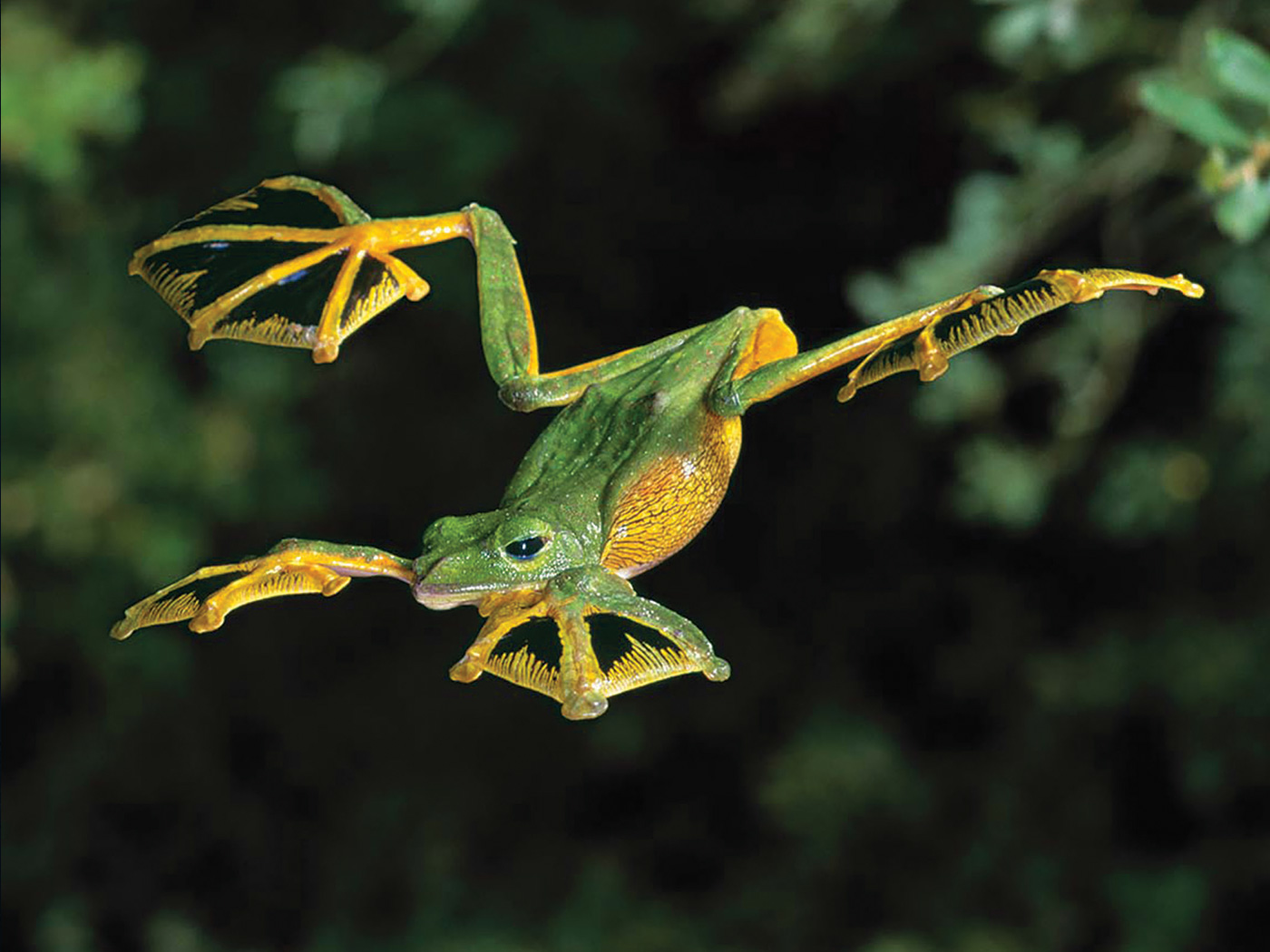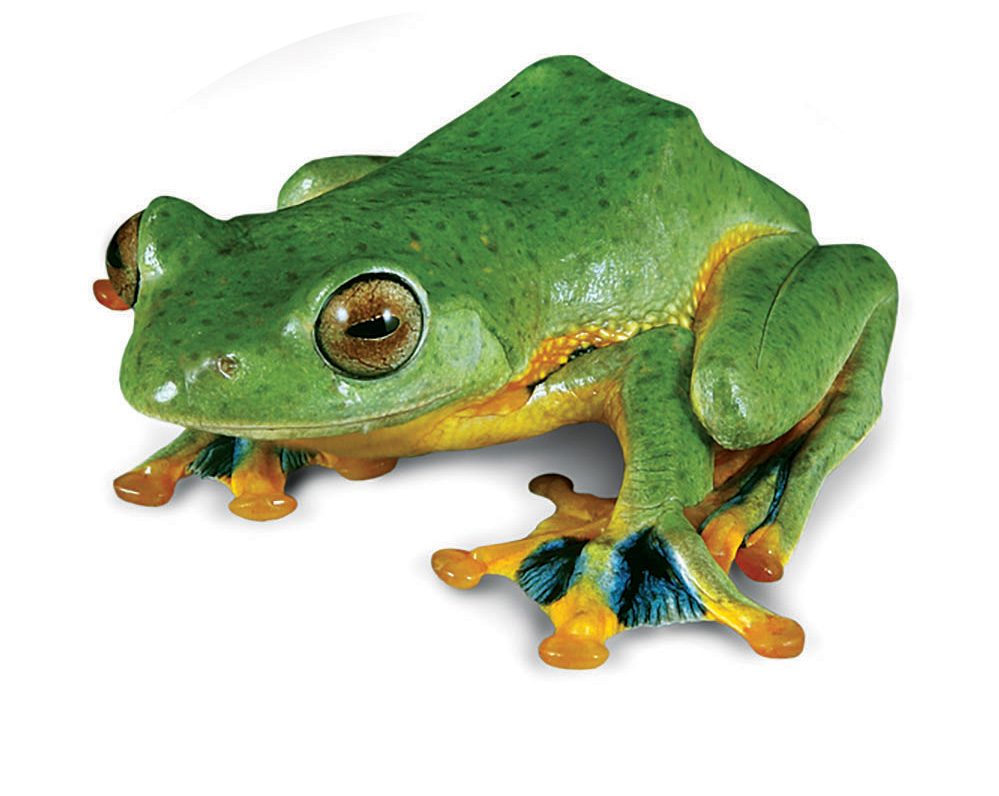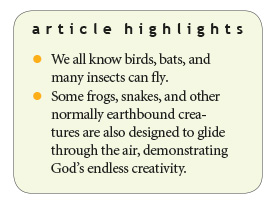
Mammals, reptiles, and even amphibians can actually glide through the atmosphere. God’s inventive engineering has equipped these unexpected animals for aerial travel. The fantastic designs of more familiar flyers like falcons and fruit bats should not fail to inspire, but each newfound aeronautical wonder in the living world offers a fresh example of God’s creativity.
God’s inventive engineering has equipped these unexpected animals for aerial travel. ![]()
Consider the so-called flying frogs. In Malaysia, the golden tree frog knows how to spread its arms and legs to control its descent from high in a jungle tree. Southeast of Malaysia, the Java flying frog uses webbed feet to resist air, slowing its descent even more. Indonesian jungles also host Wallace’s flying frog, Rhacophorus nigropalmatus. Huge webbing between its toes and its aerodynamically flattened body allow it to glide at about a 45-degree angle.
 A downside to having longer toes and extra webbing is that these features don’t help with crawling or hopping. Therefore, each of these frogs strikes a unique balance between carrying the extra flesh needed to slow an airborne descent and having more nimble limbs to increase creeping agility. Thus, the Lord deserves praise for inventing the general concept of gliding frogs, plus credit for crafting different gliding grades that enable various tree frogs to fit and fill diverse jungle niches.
A downside to having longer toes and extra webbing is that these features don’t help with crawling or hopping. Therefore, each of these frogs strikes a unique balance between carrying the extra flesh needed to slow an airborne descent and having more nimble limbs to increase creeping agility. Thus, the Lord deserves praise for inventing the general concept of gliding frogs, plus credit for crafting different gliding grades that enable various tree frogs to fit and fill diverse jungle niches.
Not only do frogs sail, but certain snakes from parts of India can expertly glide through the air. Jake Socha, a flying-snake expert at Virginia Tech’s Department of Engineering Science and Mechanics, summarized the major results from his experiments in a TEDx video.1 He found that when the flying snake Chrysopelea paradisi travels through the air, it writhes first to one side and then the other so that its average body position is symmetrical when gliding in a straight line. It can also control tight turns by whipping its body around in midair. Without these skills, the animal would tilt sideways and tumble down. The snake also rotates and flattens its many ribs, “turning its entire body into a wing.” Socha said, “This snake shape is able to generate a similar amount of lift to an engineered aerofoil. Not bad for a snake.”1 Of course, snakes don’t engineer their own features any more than airplanes do. Our brilliant Creator, not the snake, deserves all the credit.
 When it glides through the air, the flying gecko Ptychozoon kuhli extends thin skin fringes that wrap around the lizard’s sides. Plus, its skin comes camouflaged to mimic tree bark. With its standard gecko toe pads’ microscopic fibers coated with superhydrophobic (water-repelling) lipids that “glue” them to almost any surface, these lizards pack plenty of purposeful design into a tiny package.2
When it glides through the air, the flying gecko Ptychozoon kuhli extends thin skin fringes that wrap around the lizard’s sides. Plus, its skin comes camouflaged to mimic tree bark. With its standard gecko toe pads’ microscopic fibers coated with superhydrophobic (water-repelling) lipids that “glue” them to almost any surface, these lizards pack plenty of purposeful design into a tiny package.2
Borneo’s flying lizard Draco cornutus glides the farthest of all these creatures. It extends unique ribs that suspend skin webbing, like a retractable hang glider. It lives its whole life in Indonesian treetops, can shift its skin color from brown to green in active camouflage, and eats ants. If it lived in Peru, it might even eat gliding ants. Select species of tropical ants like Cephalotes atratus forage among treetops and can opt for a shortcut back to the trunk below by just jumping into the air!3 They recognize their tree trunk target, aim for it, and land expertly.
The Lord Jesus gets the credit for carefully crafting each of these gliding creatures because “by Him all things were created that are in heaven and that are on earth.” ![]()
The Lord Jesus gets the credit for carefully crafting each of these gliding creatures because “by Him all things were created that are in heaven and that are on earth.” We honor Him because “all things were created through Him and for Him.”4
References
- Socha, J. Snakes that fly—really. TEDx Virginia Tech. Posted on youtube.com December 6, 2012, accessed August 31, 2017.
- Hsu, P. Y. et al. 2012. Direct evidence of phospholipids in gecko footprints and spatula–substrate contact interface detected using surface-sensitive spectroscopy. Journal of the Royal Society Interface. 9 (69): 657-664.
- Yanoviak, S. P., R. Dudley, and M. Kaspari. 2005. Directed aerial descent in canopy ants. Nature. 433 (7026): 624-626.
- Colossians 1:16.
* Mr. Thomas is Science Writer at the Institute for Creation Research and earned his M.S. in biotechnology from Stephen F. Austin State University.









